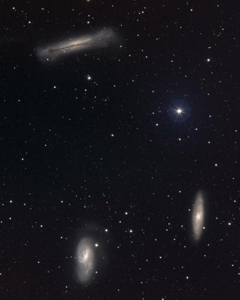Loose Groups
Galaxy groups typically contain between two and a hundred galaxies, and have been subdivided into two main types:
- In compact groups, the separations between the galaxies are not much greater than the sizes of the galaxies themselves.
- In loose groups, the galaxies are separated by distances many times the size of the individual galaxies
The velocities measured for galaxies in loose groups are quite low (~200 km/s), making these environments highly conducive to interactions and mergers between galaxies. Indeed, there is some evidence for an interaction in the loose group known as the Leo Triplet (right). The disk of NGC3628 (at the top of the image) shows clear signs of a warp which was probably created in an interaction with another galaxy.
Although still poorly understood, it is thought that loose groups will eventually evolve into compact groups and ultimately fossil groups. In this scenario, dynamical friction robs the individual galaxies of their kinetic energy, thereby reducing the separations between the galaxies. Ultimately, all the galaxies will have come so close that they merge to form a fossil group. However, this scenario only works if the galaxies encounter substantial dynamical friction as they pass through the group. Unfortunately, it is not possible to know the actual amount of dynamical friction present in loose groups without a proper description of dark matter – another area of active research for astronomers.
Study Astronomy Online at Swinburne University
All material is © Swinburne University of Technology except where indicated.


